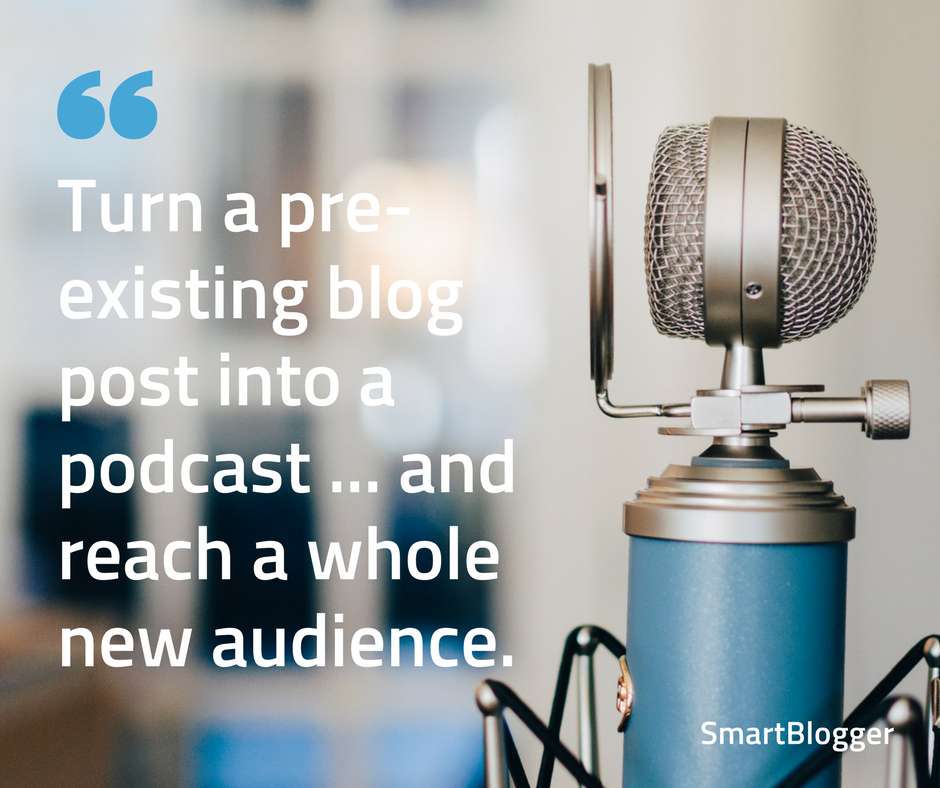
Note from Glen: I’m delighted to introduce Smart Blogger’s new Associate Editor, Robert van Tongeren. Robert’s been behind the scenes for a couple of years now, most recently as the lead instructor and editor for our Guest Blogging program. But this month he’s taking over editorial responsibilities on the blog – congratulations Robert! I’ll be focusing on running the business, freeing Jon up for more writing and of course plotting our path to world domination. 
As a blogger, you’re in the business of sharing ideas.
You have to consistently come up with new ideas and turn those ideas into blog posts that dazzle your readers. And you want to keep those readers happy and engaged, so you work your butt off to publish new posts on a regular basis.
But if you’ve been blogging for a while, you should have a treasure trove of ideas buried deep in your archives. The longer you’ve been blogging, the deeper your archives go, and the more gems are buried there.
Most bloggers are so focused on delivering new ideas that they neglect to help their readers discover the old ones, and many of those oldies are still relevant today. Many of them just haven’t been discovered by your newer followers yet.
So why not dust them off, and put them front and center again? Why not repurpose those old gems for a brand-new audience?
Below, you’ll find some ways to do just that.
#1. Produce a Bunch of Spin-Offs
Back in the 90s, when I was a young teenager — you know, zit-infested, hormones raging and desperate to uncover the secret code with which to talk to girls — one of my favorite TV shows was Buffy the Vampire Slayer. (It was awesome.)
When Buffy ended its third season, the producers did something that allowed me to spend even more of my precious youth in my favorite fictional universe. They took one character and gave him his own show, Angel.
In other words, they took an idea from Buffy and created a new show around it. See where I’m going with this?
You can do the same with your list posts. You can take a single idea from one of them and expand it into a whole new post.
For example, let’s take Glen Long’s post, 20 Rules for Writing So Crystal Clear Even Your Dumbest Relative Will Understand.
- You must clearly define your audience before writing.
- You must be able to define the topic in one simple sentence, or it’s too complex or unfocused.
- You must make a clear connection between the headline and the introduction.
Do you think these could make good topics for a blog post?
You’ll find that not all list points in a post will have enough substance to create a full article around. Sometimes they come up short — but other times you can still come up with a good post idea after some quick brainstorming.
For instance, I’m not sure if you can devote a full article to the third point in that list, but you could certainly devote a blog post to writing intros, or one about the necessity for your blog post to fulfill the promise in the headline.
And that’s not the only option you have for spinning off a post. Another way is to simply take a blog post and explore the topic from a different angle.

For example, we could take Glen’s article about writing clearly and turn it into:
And then you just turn the points from the original article on their heads:
- You’re writing without a clear picture of your audience.
- Your topic is too unfocused.
- You’re not connecting your introduction to your headline.
See how easy that is?
These spin-offs are a breeze to create, and you can then pitch them to other blogs as guest posts. Easy peasy.
#2. Showcase Your Masterpieces
Okay, you’re obviously an incredibly talented writer and — I know, I know — every post you write is a masterpiece.
But let’s be honest, every brilliant artist has pieces that stand out more than the rest.
DaVinci had his Mona Lisa, and Michelangelo (the artist, not to be confused with the ninja turtle) had his statue of David. Like them, you have stand-out pieces that are a notch or more better than the rest.
But once you’ve been publishing content for a while, some of your best posts will get buried in the archives.
Wouldn’t you want to put these front and center, so they’re easy to find for new visitors? When someone is new to your site, wouldn’t you want them to find your masterpieces first? I mean, that would make one helluva first impression, right?
So give them a little nudge in the right direction. Create a page dedicated to showcasing your best work.
See Smart Blogger’s Start Here page linked in the menu bar? You can find 30 pieces of this blog’s cornerstone content all compiled in one place, so they’re easy to find. You can spend days reading up on these alone.
Another good example is Fizzle’s Best of page, which similarly lists all its most popular content.
Note also how these pages don’t just give visitors a long list of links. Nope, the page segments the links into separate lists in a number of categories. This doesn’t just look nicer — it also makes it easier for readers to find the posts that will interest them most.
Creating a “start here” or “best of” page puts your best posts in an easy-to-find spot, so your readers can spend hours devouring them one by one.
#3. Put Your Old Posts in a New Jacket
This may come as a huge shock, but did you know a huge number of people just don’t like reading that much?
They might make time to read a bite-sized Buzzfeed post now and then, but if you presented them with Harry Potter or The Lord of the Rings, they’d ask you for the audiobook or let you know they’ve already seen the movie.
What that means is there’s a huge number of people who might not be that into your written content, but would love it if they could listen to it or watch it. That means there’s a big audience out there that you’re probably not tapping into yet.
You can reach that audience by presenting your old blog posts in a new format.
You can use content from a pre-existing blog post and turn it into a podcast, video, infographic or slideshow. That not only allows you to give your old content a fresh spin, but you can publish it on various websites with a link back to your site, delivering thousands more eyeballs to your content.

Now, I get it. The prospect of dabbling with video or audio is daunting — I hate listening to my recorded voice. Ugh!
But no worries if this seems miles out of your comfort zone because you don’t have to do it all yourself. You can hire people to repurpose your blog posts for you.
For instance, you can hire a voice actor on Fiverr to narrate your blog post, and boom — you have your podcast episode. Likewise, you can find someone on Fiverr to turn your post into a PowerPoint presentation, and boom — you have your slide show. Then you can combine the audio of your podcast with your slides, and boom — you have your video.
And you can then publish these variations of your content on various platforms dedicated to hosting people’s infographics, videos, podcasts, and slideshows.
- YouTube (Video)
- Vimeo (Video)
- Visual.ly (Infographics)
- Daily Info Graphic (Infographics)
- Amazing Info Graphics (Infographics)
- iTunes (Podcasts)
- Podomatic (Podcasts)
- Digital Podcast (Podcasts)
- Slide Share (Slide shows)
- Slide World (Slide shows)
And on top of these platforms, you can also get other bloggers to feature your infographics or videos on their websites.
All of this combined can you get you a ton of new exposure, and you can reach a whole new audience who prefer watching videos or listening to audio over reading blogs.
#4. Pass Your Posts Around
Another way to get a surge of traffic from old blog posts is to simply republish them on other sites with a bigger audience than yours.
Whoa, hey now, wait a minute! Won’t Google slap you with a duplicate content penalty for that?
Nope, that’s just a particularly popular myth in the blogging world. Matt Cutts himself has verified that there is no penalty for duplicate content unless it’s particularly spammy or keyword-stuffed.
So, in other words, don’t worry about it.
But still, even if there’s no penalty, don’t all the big blogs ask for original content only?
Well, not exactly. One popular venue for republishing content is Medium. If you’ve already read our guide to publishing on Medium, you know it can be an incredible source of traffic. Just take Benjamin Hardy, who went from zero to 50,000 subscribers by republishing on Medium.
But Medium is certainly not the only site that allows republished content.
- Business Insider
- Entrepreneur
- Fast Company
- Vox
- Mashable
- LifeHacker
- The Good Men Project
- Elephant Journal
See? You don’t need to create original content to get featured on large publications. Some of them will take articles that you’ve already published on your blog. They tend to be picky, but you’d be a fool not to give it a shot.
#5. Give Your Posts a New Lick of Paint
When you’ve been driving your car for a while, and the paint job starts to suffer, do you take it to the junkyard and buy a new one?
I think not. You just give it a new paint job and keep driving it.
Likewise, you can re-use many of the posts in your archive after giving them a little paint job.

Take Backlinko’s Brian Dean, who once received an email from a reader who used his techniques to rise to the #1 spot in Google. Brian could have created a brand-spankin’ new post to share this reader’s case study, but instead, he chose to add it to an existing post.
He not only added the case study, but he updated the images and added a few additional tips. The result — after re-promoting the post — was a 111.37% increase in traffic to that page.
You don’t always need to create brand-new content to meet your publication quota. Sometimes you can grab an old post and give it a new lick of paint. Change the publication date, and it will appear on your front page once more.
And you don’t need a case study to add to your page, either. You can refresh it many other ways.
- Add new images, screenshots, graphs, or other types of visual content
- Remove and/or replace any outdated information (including visual)
- Create a content upgrade that adds new value to the post
- Re-format the post to make it look nicer
- Improve the general readability
- Add fresh examples
- Add new information or tips
- Remove “best practices” that have stopped being best practices
- Give it a new and improved headline
Sometimes a post won’t even need an update (though you should always check before re-posting it). Sometimes you have a classic post that’s still highly relevant today and you can re-post it without changing anything.
Because if your blog has grown from 500 to 5,000 subscribers since you first published that post, that’s 4,500 subscribers who may never have seen it and may still love to read it.
That’s an easy way to lighten your workload for a week.
#6. Draw the Kindle Crowd
Many bloggers publish ebooks on Kindle to make some sweet passive income, but publishing on Kindle can also be a great source of traffic. Some Kindle readers are just waiting for you to lure them to your site.
And if you have several posts on a specific topic, you have enough (or close to enough) material for an ebook.
Honestly, you don’t need as much material as you might think — just 10,000 words is plenty for an ebook, which should be about 4-6 posts. You’ll need to connect the chapters, add an introduction and conclusion, and possibly rewrite some parts, but with those 4-6 posts, you have most of your book already written.
But before you get ahead of yourself and publish your book all willy-nilly, you should do some prep work to ensure your launch is a success.
- Assemble a support team: Ask your subscribers whether they want to join your team and get a free copy of your new book. Ask them to read the book and provide feedback. If necessary, edit your book to include any changes your team suggests.
- Publish your ebook on Kindle and set the price to $0: You want to set the price to $0 so your team won’t have to pay to download the book.
- Ask your team for reviews: Make sure you ask them to download the book before they leave their review. This is critical because when they don’t, their reviews won’t be tagged as verified.
- Promote your book: When you have a good number of reviews (20 is enough, but the more, the merrier), promote your ebook using promoters of free Kindle books like Book Marketing Tools, Freebooksy, and Bknights on Fiverr. These come with a price tag, but they can send thousands of readers your way.
- Create content upgrades: The whole idea is to get your book readers back to your site, right? So incentivize them to do so by linking to a landing page that offers supplemental material in exchange for their email. Think cheat sheets, checklists, resource lists, worksheets, templates, swipe files, or any other kind of bonus content. (If you have an upsell, you can, of course, direct them there as well.)
Once your promotion closes, you might raise the price of your ebook and boost your income, or you can leave it free and keep using it to draw traffic to your site.
In any case, during your promotion, you can expect a surge of traffic.
#7. Set up a Throwback Sequence
A few years ago, I got the opportunity to work on the Spanish island of Mallorca for six months. Having grown up in the always-rainy Netherlands, I grabbed this opportunity so hard, that I made it cry crocodile tears.
The problem? I had a year-and-a-half-old blog with a growing audience. I could spend all my time in Mallorca working, or I could choose to abandon it for a little while.
Forgive me, but I chose the latter. I sent my existing subscribers a note that I wouldn’t be around for a while. I figured I’d lose a few along the way, but it was worth the risk. At the same time, though, I didn’t want my first impression on new readers (who subscribed while I was gone) to be, “Hey, see you in six months!”
So I set up an autoresponder that would periodically send them one of my older blog posts. That way, by the time I got back, they’d have received word from me on a steady basis.
And when I got back, I realized this wasn’t a half-bad idea. I realized this was a hands-off way to consistently send traffic to my older content. Once you’ve installed your autoresponder, it will promote your posts on autopilot.
So I just kept it running. To this day, every new subscriber receives a link to an old blog post every so often.
I like to call this a throwback sequence.
We all know how effective email marketing is, so why not use it to promote your older posts as well? You can set it to trigger at sign-up and install it to send a monthly or bi-weekly email.
Your only job it to update it on occasion. Since the throwback sequence can run for a year (or years), you can just keep adding posts as you publish them.
Just ensure that when you add a new post, you add a provision for it not to send to subscribers who signed up before its publication date, or it will send your posts to subscribers who have already read it.
Keep Your Classics Alive
Imagine if you had never heard musical classics like Bohemian Rhapsody, Thriller or Hotel California simply because you weren’t around when they were first released.
That would suck, right? Because they’re amazing songs that sound just as epic today as they did back then. They don’t stop being valuable just because they’re not brand new.
And it’s the same for your blog posts. Many of those you debuted months or even years ago are still valuable today, so give them the attention they deserve. Help new audiences uncover the treasure trove of ideas buried in your archives.
Update and re-post them. Write some spin-offs. Set up a throwback sequence. Step out of your comfort zone and put them in a new format. Whatever you do, don’t let them disappear into obscurity.
Keep playing those golden oldies. Because people out there still want to hear them.
from
https://smartblogger.com/repurposing-content/
No comments:
Post a Comment